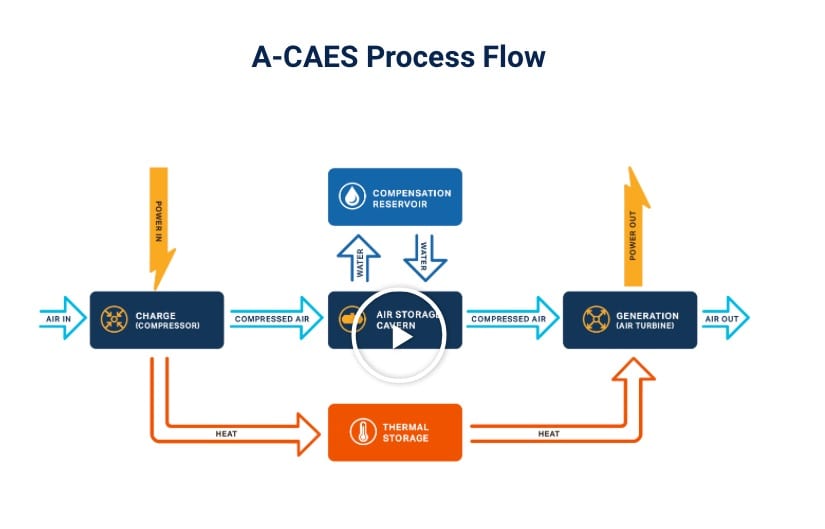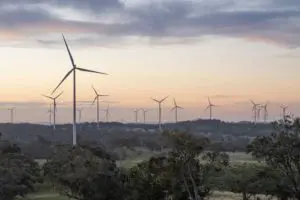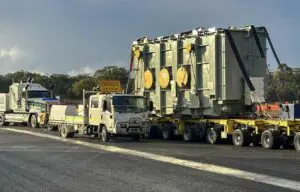Canadian storage company Hydrostor and Australia’s Energy Estate have released a bullish economic impact study of their proposed 200MW advanced compressed air energy storage facility near Broken Hill, which would be the largest of its kind in the world.
Hydrostor’s technology was last year chosen by Transgrid as its preferred option for its network and renewable micro-grid proposal for the remote mining and tourism town and the surrounding region, and it also received funding for a feasibility study from the NSW government’s Emerging Renewables plan.
Storage is considered essential for the region given its isolation, its dependence on a single transmission line, and the presence of a 200MW wind farm (Silverton, pictured above) and a 50MW solar farm that are often heavily restricted on the amount of electricity they can send down the line.
AGL, a part owner of those two wind and solar projects, is also looking at a 50MW big battery as a potential solution, but the compressed air storage proposal has its supporters because of the length and depth of storage – if it can be made to work economically on such a grand scale.
Compressed air storage works on a similar theme to pumped hydro, using times of low prices to “charge up” and store significant amounts of energy. Instead of using water, rare in remote areas, it compresses air in suitable caverns, the type that can be found in old mines.
The new Hydrostor study doesn’t appear to answer the important question of whether it is commercially viable, which is a valid concern given its failure to secure funding offered by ARENA for a smaller project at an abandoned zinc mine in South Australia.
Still, Hydrostor says a study produced by prominent energy advisory group ACIL Allen suggests the 200MW project, which would have eight hours storage, and would cost around $560 million and deliver significant benefits to the region.
The project will employ an average of 260 full time equivalent (FTE) construction jobs over three years, with a peak in the second year of 350 workers, and the project would deliver around $12 million in annual operating expenditures for the region once up and running.
Hydrostor says the presence of a major storage facility will be good for the local economy, as it will provide the grid support for the cheap renewables on offer and help advance mining and maybe even manufacturing investments in the region, without having to trick in dirty and expensive diesel.
“New South Wales is one of the first regions to future proof its transition to renewable energy by investing in long duration energy storage,” Curtis VanWalleghem, the CEO of Hydrostor, said in a statement.
“Hydrostor’s A-CAES system will allow renewable energy to support the grid on-demand, even in unfavourable weather conditions for wind or solar energy. This supports the direct replacement of fossil fuels and protects the Broken Hill energy system for generations.”
Hydrostor is co-developer of the project along with Australia’s Energy Estate, whose principal Simon Currie says the long duration energy storage will facilitate the development of new renewable energy projects, as well as service the local community and new and existing mining loads.
“Compressed air projects can be sited more flexibly than other viable long duration options such as PHES and Broken Hill is the first in a pipeline of projects we plan to jointly develop in Australia.”
Currie told RenewEconomy that a site at a disused mine is being discussed, but can’t be revealed until negotiations are finalised. A final investment decision will likely be decided by the lengthy regulatory review process that is required of transmission companies like Transgrid.
Currie also points to a US Department of Energy study last year that identified compressed air storage as one of the most competitive storage technologies.
“The numbers we talk about are $50-$75/MWh, depending on the size and structure of the cavern,” Currie said.
Currie says the opportunities for “new minerals” to accompany the global renewable and EV revolution means there is a growing market to extend the life of many major mines in Australia, as long as they can source cheap and reliable power.
And the mayor of Broken Hill, Darriea Turley, is also a fan.
“This is a very exciting and innovative project for Broken Hill, and one that I think will be welcomed by locals. It will bring employment and energy security to our region and provide a new method of utilising mining infrastructure,” he said in a statement.
“This project aligns with Council’s own Renewable Energy Action Plan and Sustainability Strategy and will complement renewable energy projects in our city well into the future.”











